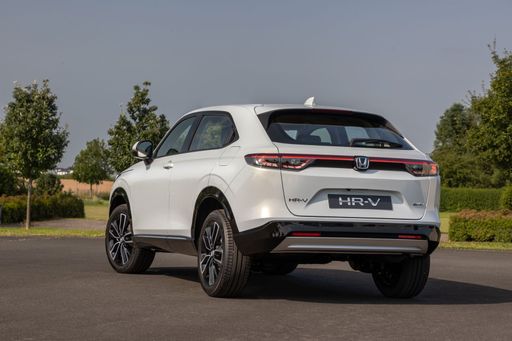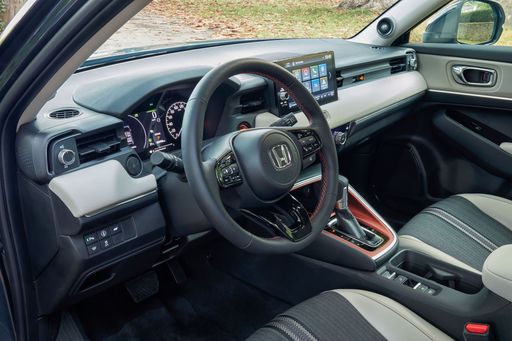Honda HR-V vs Omoda 5 - Differences and prices compared
Costs and Efficiency:
Price and efficiency are key factors when choosing a car – and this is often where the real differences emerge.
Omoda 5 has a noticeable advantage in terms of price – it starts at 23100 £, while the Honda HR-V costs 29700 £. That’s a price difference of around 6600 £.
Fuel consumption also shows a difference: Honda HR-V manages with 5.40 L and is therefore clearly perceptible more efficient than the Omoda 5 with 7.50 L. The difference is about 2.10 L per 100 km.
Engine and Performance:
Power, torque and acceleration are the classic benchmarks for car enthusiasts – and here, some clear differences start to show.
When it comes to engine power, the Omoda 5 has a clearly perceptible edge – offering 204 HP compared to 131 HP. That’s roughly 73 HP more horsepower.
In acceleration from 0 to 100 km/h, the Omoda 5 is evident quicker – completing the sprint in 7.80 s, while the Honda HR-V takes 10.60 s. That’s about 2.80 s faster.
In terms of top speed, the Omoda 5 performs distinct better – reaching 220 km/h, while the Honda HR-V tops out at 170 km/h. The difference is around 50 km/h.
There’s also a difference in torque: Omoda 5 pulls a bit stronger with 290 Nm compared to 253 Nm. That’s about 37 Nm difference.
Space and Everyday Use:
Whether family car or daily driver – which one offers more room, flexibility and comfort?
Seats: offers more seating capacity – vs .
In terms of boot space, the Honda HR-V offers convincingly more room – 319 L compared to 0 L. That’s a difference of about 319 L.
In maximum load capacity, the Honda HR-V performs slightly better – up to 1289 L, which is about 214 L more than the Omoda 5.
Who comes out on top?
Overall, the Omoda 5 shows itself to be offers a more balanced package and secures the title of DriveDuel Champion.
It convinces with the more balanced overall package and proves to be the more versatile choice for everyday use.

Omoda 5
Costs and Consumption
View detailed analysis
Engine and Performance
View detailed analysis
Dimensions and Body
View detailed analysis
Honda HR-V
The Honda HR-V is the sensible compact crossover that blends roomy practicality with a composed, friendly drive, making it an easy pick for buyers who want everyday usability without fuss. It won’t thrill hardcore enthusiasts, but its clever packaging, comfortable cabin and low-key styling make life simpler — and that’s exactly the point.
details @ Honda Motor Co., Ltd.
@ Honda Motor Co., Ltd.
 @ Honda Motor Co., Ltd.
@ Honda Motor Co., Ltd.
 @ Honda Motor Co., Ltd.
@ Honda Motor Co., Ltd.
 @ Honda Motor Co., Ltd.
@ Honda Motor Co., Ltd.
Omoda 5
The Omoda 5 arrives as a stylish, tech-forward compact crossover that punches above its class with bold design and a surprisingly premium cabin. It’s an attractive choice for buyers who want modern gadgets, confident road manners and value without the usual showroom drama.
details
 @ Honda Motor Co., Ltd.
@ Honda Motor Co., Ltd.
|
|
|
|
|
Costs and Consumption |
|
|---|---|
|
Price
29700 - 35400 £
|
Price
23100 £
|
|
Consumption L/100km
5.40 L
|
Consumption L/100km
7.50 L
|
|
Consumption kWh/100km
-
|
Consumption kWh/100km
-
|
|
Electric Range
-
|
Electric Range
-
|
|
Battery Capacity
-
|
Battery Capacity
-
|
|
co2
122 g/km
|
co2
-
|
|
Fuel tank capacity
40 L
|
Fuel tank capacity
51 L
|
Dimensions and Body |
|
|---|---|
|
Body Type
SUV
|
Body Type
SUV
|
|
Seats
5
|
Seats
5
|
|
Doors
5
|
Doors
5
|
|
Curb weight
1452 kg
|
Curb weight
-
|
|
Trunk capacity
319 L
|
Trunk capacity
0 L
|
|
Length
4355 mm
|
Length
4424 mm
|
|
Width
-
|
Width
1830 mm
|
|
Height
1582 mm
|
Height
1588 mm
|
|
Max trunk capacity
1289 L
|
Max trunk capacity
1075 L
|
|
Payload
418 kg
|
Payload
-
|
Engine and Performance |
|
|---|---|
|
Engine Type
Full Hybrid
|
Engine Type
Petrol
|
|
Transmission
Automatic
|
Transmission
Automatic
|
|
Transmission Detail
CVT
|
Transmission Detail
Dual-Clutch Automatic
|
|
Drive Type
Front-Wheel Drive
|
Drive Type
Front-Wheel Drive
|
|
Power HP
131 HP
|
Power HP
204 HP
|
|
Acceleration 0-100km/h
10.6 - 10.8 s
|
Acceleration 0-100km/h
7.80 s
|
|
Max Speed
170 km/h
|
Max Speed
220 km/h
|
|
Torque
253 Nm
|
Torque
290 Nm
|
|
Number of Cylinders
4
|
Number of Cylinders
4
|
|
Power kW
96 kW
|
Power kW
145 kW
|
|
Engine capacity
1498 cm3
|
Engine capacity
1598 cm3
|
General |
|
|---|---|
|
Model Year
2025
|
Model Year
2024
|
|
CO2 Efficiency Class
D
|
CO2 Efficiency Class
-
|
|
Brand
Honda
|
Brand
Omoda
|
What drive types are available for the Honda HR-V?
The Honda HR-V is available as Front-Wheel Drive.
The prices and data displayed are estimates based on German list prices and may vary by country. This information is not legally binding.
